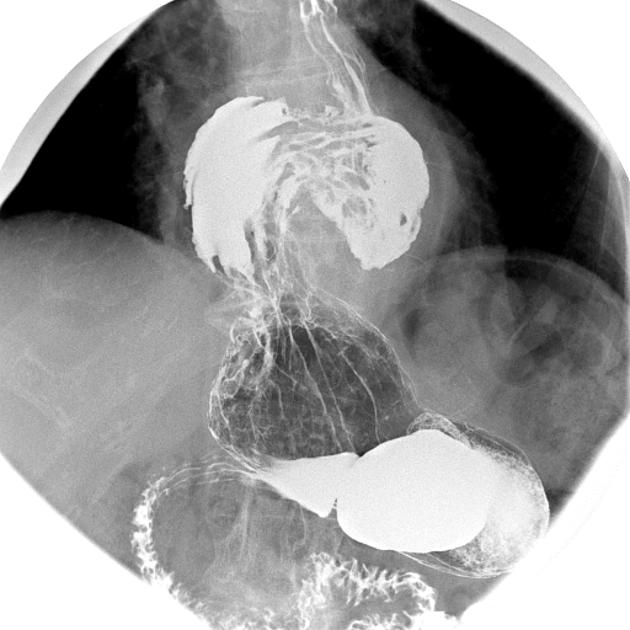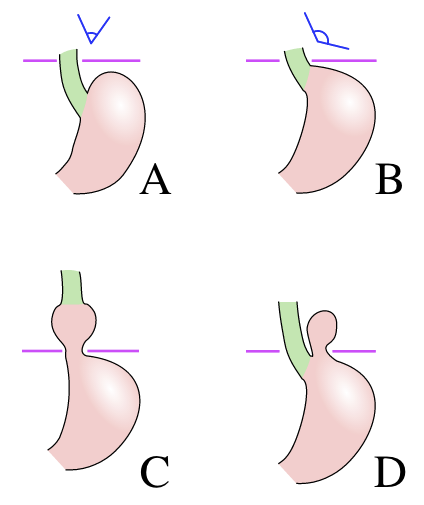WBR1104
| Author | PageAuthor::William J Gibson |
|---|---|
| Exam Type | ExamType::USMLE Step 1 |
| Main Category | MainCategory::Anatomy, MainCategory::Pathophysiology |
| Sub Category | SubCategory::Gastrointestinal, SubCategory::Pulmonology |
| Prompt | [[Prompt::A 65-year-old woman presents to her primary care physician complaining of early satiety, abdominal distention, and nausea after meals. Abdominal exam is negative for hepatosplenomegaly or other occult masses. The patient is prescribed omeprazole for presumed gastroesophageal reflux disease. Two weeks later, the patient returns to the hospital reporting no relief of symptoms. A barium swallow imaging study is shown below.
At which of the following levels does the disturbed structure normally pass through the diaphragm?]] |
| Answer A | AnswerA::T4 |
| Answer A Explanation | AnswerAExp::T4 lies at the level of the nipple. A hiatal hernia occurs lower in the body. |
| Answer B | AnswerB::T6 |
| Answer B Explanation | AnswerBExp::T6 lies at the level of the xiphoid process. |
| Answer C | AnswerC::T8 |
| Answer C Explanation | AnswerCExp::The inferior vena cava passes through the diaphragm at the level of the T8 vertebrae. |
| Answer D | AnswerD::T10 |
| Answer D Explanation | AnswerDExp::The esophagus normally passes through the diaphragm at the level of the T10 vertebrae. |
| Answer E | AnswerE::T12 |
| Answer E Explanation | AnswerEExp::The aorta passes through the diaphragm at the level of the T12 vertebrae. |
| Right Answer | RightAnswer::D |
| Explanation | [[Explanation::The patient in this vignette has developed a hiatal hernia, in which a portion of the stomach has passed through the diaphragm and into the thorax. In the barium swallow study, a portion of the stomach (highlighted by barium) can be seen superior to a stricture that forms the esophageal hiatus in the diaphragm.
Hiatal hernia has often been called the "great mimic" because its symptoms can resemble many disorders. For example, a person with this problem can experience dull pains in the chest, shortness of breath (caused by the hernia's effect on the diaphragm), heart palpitations (due to irritation of the vagus nerve), and swallowed food "balling up" and causing discomfort in lower esophagus until it passes on to stomach. The abdominal pain this woman experienced after meals was due to improper trafficking of food through the digestive system and acid reflux. In most cases however, a hiatal hernia does not cause any symptoms. The pain and discomfort that a patient experiences is due to the reflux of gastric acid, air, or bile. While there are several causes of acid reflux, it does happen more frequently in the presence of hiatal hernia. There are two major kinds of hiatal hernias: • The most common (95%) is the sliding hiatus hernia, where the gastroesophageal junction moves above the diaphragm together with some of the stomach (Pictured in C below). • The second kind is rolling (or paraesophageal) hiatus hernia, when a part of the stomach herniates through the esophageal hiatus and lies beside the esophagus, without movement of the gastroesophageal junction. It accounts for the remaining 5% of hiatus hernias (Pictured in D below).
|
| Approved | Approved::Yes |
| Keyword | WBRKeyword::Diaphragm, WBRKeyword::Thorax, WBRKeyword::Hernia, WBRKeyword::Hiatal hernia, WBRKeyword::Barium, WBRKeyword::Upper GI, WBRKeyword::Swallow, WBRKeyword::Swallowing, WBRKeyword::Radiology, WBRKeyword::Chest X ray, WBRKeyword::Stomach, WBRKeyword::Esophagus |
| Linked Question | Linked:: |
| Order in Linked Questions | LinkedOrder:: |

